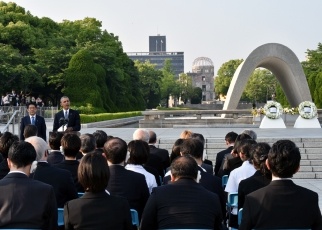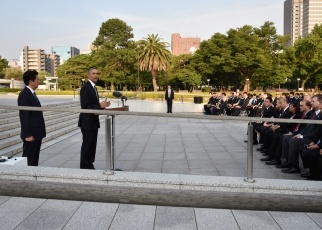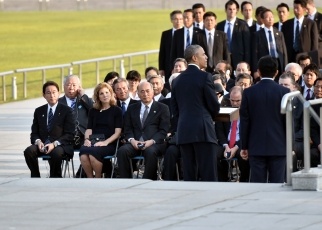Japan-United States of America Relations
The President of the United States Visits Hiroshima
 The two leaders shaking hands after laying wreaths at the Hiroshima Peace Memorial Park
The two leaders shaking hands after laying wreaths at the Hiroshima Peace Memorial Park
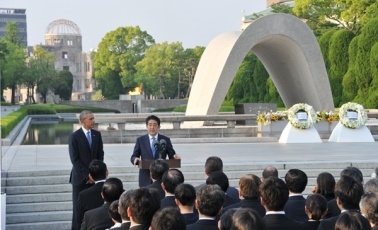 Prime Minister Shinzo Abe delivering a statement
Prime Minister Shinzo Abe delivering a statement (Photo: Cabinet Public Relations Office)
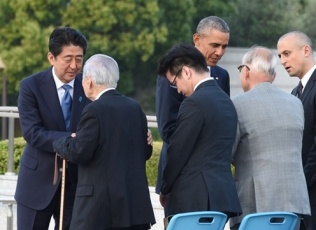 The two leaders meeting with atomic bomb survivors
The two leaders meeting with atomic bomb survivors (Photo: Cabinet Public Relations Office)
On May 27, the Honorable Barack H. Obama, President of the United States of America, accompanied by Mr. Shinzo Abe, Prime Minister of Japan, visited Hiroshima, as the first sitting U.S. President to visit the city. The overview of the visit is as follows:
1. Overview
(1) Visit to the Hiroshima Peace Memorial Museum
After arriving at the Hiroshima Peace Memorial Park, President Obama was welcomed by Prime Minister Abe, and then met, in front of the Hiroshima Peace Memorial Museum, Mr. Fumio Kishida, Minister for Foreign Affairs of Japan, Mr. Hidehiko Yuzaki, Governor of Hiroshima Prefecture, and Mr. Kazumi Matsui, Mayor of Hiroshima City. While at the museum, Minister Kishida gave an overview of the museum and explanations of its exhibits, including Sadako Sasaki’s folded paper cranes. Appearing to have done a considerable amount of study in advance, President Obama listened attentively to Minister Kishida’s explanations while looking intently at the exhibits. Subsequently, the President handed to two local Hiroshima children with folded paper cranes that he explained he had folded by himself, with a little help. Prime Minister Abe and President Obama signed the guest book respectively, and President Obama placed two more folded paper cranes beside it.
(Reference) The guest book entries
| Prime Minister Abe | : | I express my sincere condolences to all the victims of the atomic bombings. I pray for lasting peace and will do my utmost to realize a world free of nuclear weapons. |
| President Obama | : | We have known the agony of war. Let us now find the courage, together, to spread peace and pursue a world without nuclear weapons. |
(2) Laying wreaths at the Hiroshima Peace Memorial Park
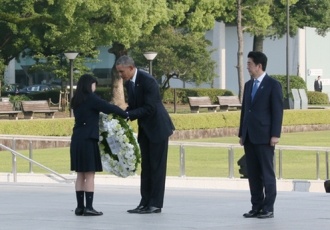 Laying wreaths at the Cenotaph for the Atomic Bomb Victims
Laying wreaths at the Cenotaph for the Atomic Bomb Victims (Photo: Cabinet Public Relations Office)
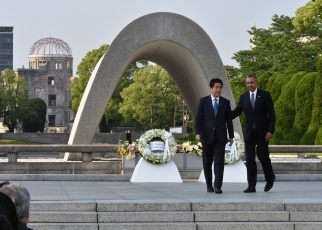 President Obama walking with Prime Minister Abe
Laying wreaths at the Cenotaph for the Atomic Bomb Victims
President Obama walking with Prime Minister Abe
Laying wreaths at the Cenotaph for the Atomic Bomb Victims
In a solemn atmosphere, the two leaders proceeded to the Cenotaph for the Atomic Bomb Victims, led by Governor Yuzaki, Mayor Matsui, Minister Kishida and H.E. Ms. Caroline Kennedy, Ambassador of the United States of America to Japan. There, the leaders were handed wreathes by Hiroshima high-school students who have been commissioned as “Youth Communicators for a World without Nuclear Weapons,” and first, President Obama and then, Prime Minister Abe laid the wreath and offered a silent prayer.
(3) Delivery of statements
President Obama, followed by Prime Minister Abe, delivered a statement. Powerful messages on realizing “a world free of nuclear weapons” were stated by the leader of the only country to have used nuclear weapons and the leader of the only country to have ever suffered atomic bombings.
(4) Meeting with atomic bombings survivors
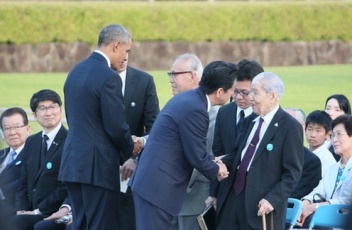 The two leaders meeting with atomic bomb survivors
The two leaders meeting with atomic bomb survivors (Photo: Cabinet Public Relations Office)
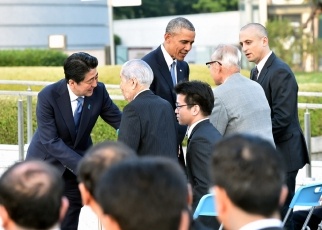 The two leaders meeting with atomic bomb survivors
The two leaders meeting with atomic bomb survivors
After the statements were delivered, President Obama walked over to atomic bomb survivors, Mr. Sunao Tsuboi and Mr. Shigeaki Mori, and exchanged words with each of them.
Mr. Tsuboi (91), who was invited to attend by the Government of Japan, serves as Chairperson of the Japan Confederation of A- and H-Bomb Sufferers Organizations (Nihon Hidankyo), a nationwide organization of atomic bomb survivors of Hiroshima and Nagasaki (Hibakusha). Mr. Mori (79), who was invited by the Government of the United States, survived the atomic bombing of Hiroshima himself and subsequently spent many years researching 12 American prisoners-of-war who died in the bombing, in order to inform their bereaved families.
(5) Explanation of the Atomic Bomb Dome
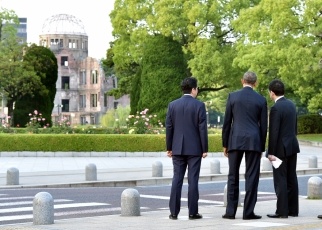 Viewing the Atomic Bomb Dome
Viewing the Atomic Bomb Dome
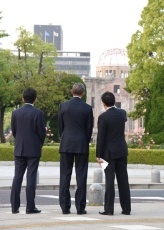 Viewing the Atomic Bomb Dome
Viewing the Atomic Bomb Dome (Photo: Cabinet Public Relations Office)
The two leaders proceeded toward the Atomic Bomb Dome. They viewed the dome from the Flame of Peace’s north side, and Minister Kishida provided an explanation. President Obama listened attentively to Minister Kishida’s explanation that the Atomic Bomb Dome was designated a World Heritage Site in 1996 and is a symbol of the bombsite. Minister Kishida also told President Obama about the Children's Peace Monument and the folded cranes that have been sent from around the world, which were immediately in front of them.
2. Evaluation
President Obama’s visit to Hiroshima was the first visit by a sitting U.S. President and it was an extremely important historical event in terms of commemorating the war dead and revitalizing international momentum for realizing a world free of nuclear weapons. At the same time, the visit symbolized the strength of the U.S.-Japan Alliance, an “Alliance of Hope,” which has been built up over the more than 70 years since the war.


